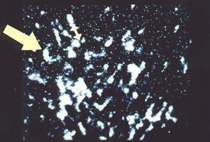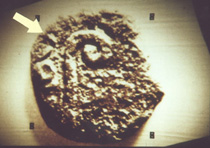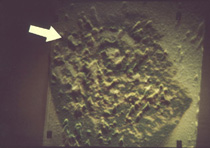Skip to comments.
MAN OF THE SHROUD
Various ^
| August 2002
Posted on 08/03/2002 6:33:43 AM PDT by NYer

The Shroud of Turin is a centuries old linen cloth that bears the image of a crucified man. A man that millions believe to be Jesus of Nazareth. Is it really the cloth that wrapped his crucified body, or is it simply a medieval forgery, a hoax perpetrated by some clever artist? Modern, twentieth century science has completed hundreds of thousands of hours of detailed study and intense research on the Shroud. It is, in fact, the single most studied artifact in human history, and we know more about it today than we ever have before. And yet, the controversy still rages.
Arguments against the Shroud's authenticity are prima facia, supported by carbon 14 dating and a prevailing view of the way things are in the world. On the other hand, the case for authenticity is a compelling preponderance of scientific and historic evidence. So daunting is the evidence that we can only wonder if, as postmodernists suggest, "no such thing as objective truth exists, that historic reality is an inherently enigmatic and endlessly negotiable bundle of free-floating perceptions."1 The alternative is to consider, as C. S. Lewis contends: rare exceptions to nature are possible.
On this hot and sultry day in August, I decided to post this thread for those who enjoy mystery, adventure and the thrill of discovery. There are many web sites devoted to this topic. I suggest you begin here:
SHROUD OF TURIN
TOPICS: General Discusssion
KEYWORDS: medievalhoax; shroudofturin; sudariumofoviedo; veronicaveil
Navigation: use the links below to view more comments.
first previous 1-20, 21-40, 41-60, 61-80 ... 281-299 next last
To: Catholicguy; HumanaeVitae
Thank you,
Catholicguy for posting that link!
The flagrum, a whip of two or three thongs with small lead pellets attached, was wielded by a torturer who moved round his victim, or by two torturers, one of whom struck from behind. Jesus lost a great deal of Blood, for a reason only mentioned by Saint Luke, "with the unsurpassable precision of a medical doctor", writes Barbet; perhaps because he had questioned Saint John, the beloved disciple who did not fall asleep on the Mount of Olives:
"And being in an agony, He prayed all the more earnestly. And His sweat became as drops of blood trickling down upon the ground." (Lk 22.44)
Fr. Benedict Groeschel appeared on EWTN's program Mother Angelica Live, the other night. He mentioned the shroud, in connection with the crucifixion and burial of Christ. Of course, Fr. Groeschel has a style all his own. Pointing to all the famous artwork we have seen over the years, and the artist's depiction of the crucifixion, he reminded viewers that artists approach their subjects much like a photographer. These are "tableaux". Each person present at the crucifixion has a certain place "in the tableau". In reality, he said, the actual crucifixion of Jesus was something far more barbaric and brutal than any artist would care to render.
He went on to speak about a good friend, a priest, who has a parish in Rhode Island. When his friends parish was condemned by the city council in order to run a highway through that property, this priest set about building a new church. For the "corpus" on the crucifix, he contacted the group that had done the 3D imaging of the Shroud of Turin. He then went on to say that they have now been able to count the number of whiplashes on the man of the shroud - 110! Fr. Groeschel noted, in his inimitable style, that it was miracle enough that this "man of the shroud" was able to walk the Via Dolorosa carrying a crossbar, with his skin tattered into shreds by that number of blows. The normal punishment, according to all public records handed down from that period, would have been 30.
21
posted on
08/03/2002 5:18:20 PM PDT
by
NYer
To: NYer
If anyone finds another piece of ancient cloth which contains a 3-D topographic map of a human body embedded in a pigment-free negative image, please let me know.
The fire affected the Carbon-14 dating.
To: RMrattlesnake
You're in over your head.
To: Aquinasfan
I have my proof of GOD it is the King James bible you can have your old cloth, it will burn in the end it will pass away but the word of God will last for ever. I know more believe the Garbage about the Shourd than I believe in UFO's or that crystals have healing power. I guess you believe in the Lochness monster.
To: RMrattlesnake
Why don't you think the Shroud is genuine?
To: Desdemona
I live in the Dayton area. I know personally one of the AF researchers that examined the Shroud in the late 70's. I have yet to meet a Catholic around here that does not believe in the Shroud's authenticity. I admit this is anecdotal but it is pretty overwhelming. Is your info scientific or anecdotal?
Godspeed, The Dilg
26
posted on
08/03/2002 8:18:00 PM PDT
by
thedilg
To: Aquinasfan



4 - The area over the anatomical right eye of the Shroud image (a computer enhancement of the Enrie photograph), showing the letters UCAI and the lituus (the arrow points to the upper third of the critical letter C; the letters are about 1.5 mm high).
5 - A Pontius Pilate lepton ("window's mite") owned by Francis Filas, showing the highly specific lituus, or auger, or astrologer's staff design, the frequent clipped edge from one to four o'clock, and, despite erosion, parts of the letters TIOUCAI (again, the arrow points to the letter C).
6 - The overlapped images, showing the almost perfect congruence of the two indicating that this coin was struck from the same die as the coin over the Shroud image's right eye.
To: thedilg
That would be...scientific. Please see above post.
To: RMrattlesnake
I love the majesty of the King James Bible. I believe the bible to be the inerrant word of God. I hope you don't mind if I also believe in the authenticiry of the Shroud. Is it not possible that God is the author of both?
Godspeed, The Dilg
29
posted on
08/03/2002 8:36:05 PM PDT
by
thedilg
To: NYer
A man at my parish does presentations on this. He is a chemistry teacher at the community college level and knows a lot about The Shroud of Turin. Unfortunately, the last time he gave a talk, I was unable to attend.
To: HumanaeVitae
I am interested to see the photographs, but - sorry to be negative - I see very little in the original shroud picture, which has been "computer enhanced" (should that just be "computer magnified?") Is doesn't look like anything to me! I am sure that I could fit it over the map of a glacier, and find points in common.
However, it is interesting to discuss the Shroud. In my opinion, it came from the Middle East, and was probably brought back by the Crusaders. Even if it is not genuine, it is still a venerable and interesting image, fruitful for meditation, and sanctified by the prayers offered by the faithful.
To: NYer
It's an amazing artifact - one that I believe could certainly be the true shroud of Christ. I hope and pray that I should someday be able to see it.
To: NYer
Thank you,NYer for this thread.I just scanned it and the link.And it looks very interesting.Bumping for a later read.
To: thedilg; NYer
Maybe I should clarify someting - I believe the shroud is authentic.
I always have. Even as a kid. Since then, I've worked with archival artifacts (in a past life) and 2000 year old pieces of cloth just don't look like that. And yes, the fire screwed up the carbon-14 dating. I have no doubt of that.
Too many things point to authenticity, on top of my belief that authentic things generally survive. Supposedly the crown of thorns is in Paris. The French stole it at some point. (Don't let them kid you: they're only athiests because it's fashionable)
And then, I also believe strongly that a higher power watches and intervenes. True story: a sister of a friend lives in San Francisco had two bookcases of breakable figurines. In the earthquake in 1989, the really valuable ones, antique Hummels, were in one bookcase which fell over and every one was destroyed. It wasn't a life. On the other, everything fell off of it except the statue of Mother Duchesne, which didn't move.
A fire that can melt silver is hot enough to get wood and other natural fibers to spontaneously combust. There's no way anyone can convince me the shroud isn't authentic.
To: NYer
What about the crown of thorns. The shroud has evedence of some sort of thisle but it is the wrong plant to be the crown of thorns.
To: HumanaeVitae
The book is a blockbusterJust ordered it at Amazon.com. Thanks for the recommendation.
36
posted on
08/04/2002 7:10:04 AM PDT
by
NYer
To: RMrattlesnake; BlackVeil
What about the crown of thorns

The image is that of a muscular Jewish male, about five feet eleven inches tall, weighing about 170 pounds, about age 35, whose body is in cadaveric spasm (a type of near instantaneous rigor mortis occurring in those severely traumatized), and who has a spear wound through the right chest into the heart with a post mortem flow of blood and serum from the wound. The appearance of the blood clots shows that the body disappeared from within the Shroud without the cloth being unwrapped. The appearance of the blood clots and the body, as well as the images of the flowers, indicates that this event took place between 24 and 36 hours after death.
The image of a crown of thorns is visible on the Shroud, and history records only one use of a crown of thorns. The image records a remarkable event between 24 and 36 hours after death when the body abruptly disappeared, leaving its image in vertically directed electron corona and soft X-ray radiation. To more certainly identify the Man of the Shroud, the title (the sign over the head) and several letters in Greek and Latin of Jesus of Nazareth are faintly visible on the Shroud.
The images of 28 flowers and thorns on the Shroud, twenty of which grow in Jerusalem, and the other eight within 12 miles of Jerusalem. Most do not grow in Europe at all. Pollens of twenty-five of these species had been previously and independently identified by Dr. Max, a noted Swiss criminalist and botanist, from sticky tape slides that he took from the Shroud in 1973 and 1978. Their common blooming time is March and April.
37
posted on
08/04/2002 7:30:52 AM PDT
by
NYer
To: NYer
However--it's a little science-intensive in parts...but it's worth the read. ;-}
To: Desdemona
"And then, I also believe strongly that a higher power watches and intervenes"
The book "The Resurrection of the Shroud" runs through the history of the Shroud. It was first known as the Image of Edessa, then the Mandylion, then the "Shroud". Here's an excerpt from the book:
"The rediscovery of the Image of Edess in the sixth century shed valuable light on the cloth's disappearance centuries earlier. According to the "Story of the Image of Edessa", the closth was found in a space above the city's (Edessa's) western gate...when Ma'nu VI (Edessa's ruler) returned to paganism and began persecuting Chrisians...someone hid (the Shroud/Image of Edessa)there for safekeeping since persecution of Christians and destruction of their relics and vestiges were most likely occuring. This choice of a hiding place proved fortuitous, for it not only save the Christian relics from destruction by the pagan ruler, but it also provided a hermeticallly sealed environment for the (Shroud) for the next five centuries...the location turned out to be important for another reason: Edessa suffered severe floods in 201, 303, 413, and 525...fotunately (none of) these floods rose to the level of the western gate, where (the Shroud was hidden)."
To: RMrattlesnake
I guess you believe in the Lochness monster. I know this is waaay off-topic but I have always thought this was interesting ever since I was told this story.
My wife and I were living in London in early 1998 doing a Christian Counseling course with Youth With A Mission. One of the other people on the course was a shy, affable and very inteligent young woman whom we got to know very well. She came from a fairly well to do family, but she never bragged about it; I think she might have been uncomfortable with how people would relate to her because of her upbringing. Once or twice, however, she did let slip that her family sometimes spent their summers in Scotland, though she offered no more information than that. After three months, we were receiving our assignments for the outreach phase of the school, and my wife and I had felt called to work up in Edinburgh. So, we asked her, since she had spent some time there, about where she spent her summers and what is there to see, if we had a chance to slip away for a weekend.
She told her her family rented out a house in Inverness, near the loch. Well, just as a joke, I asked her if she had ever seen the Loch Ness Monster. She kind of looked down, ackwardly, and replied that yes, indeed she had. She then proceeded to tell us the story (in much more detail than this) that basically her and a few of her brothers were walking along the edge of the loch one evening, as it was getting dark. Ahead, they saw a figure lying across the path. Thinking it might be someone hurt, they quickened their walk towards it. But, as they came closer, they saw that what they thought was a body was actually the neck of a very large creature whose body was still submurged into the loch. They stopped suddenly. The creature then lifted its head, stared at them for a moment, then turned and silently disappeared back into the loch.
She told us that she doesn't like talking about it, espically to Christians, because she is afraid that people would think she was into New Age stuff or even doubt her sanity. But, since seeing it, she starting cautiously tellings others about what she saw, and she told us that there are many others around that loch that told her that they too have seen that creature, some on several occasions.
After knowing her on that school and after, and knowing that she does not have any tendancy towards telling shady stories, let along having a dishonest bone in her body, I can only conclude that she, indeed, saw the Loch Ness Monster.
Navigation: use the links below to view more comments.
first previous 1-20, 21-40, 41-60, 61-80 ... 281-299 next last
Disclaimer:
Opinions posted on Free Republic are those of the individual
posters and do not necessarily represent the opinion of Free Republic or its
management. All materials posted herein are protected by copyright law and the
exemption for fair use of copyrighted works.
FreeRepublic.com is powered by software copyright 2000-2008 John Robinson




